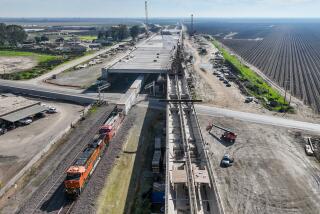Help wanted: chief executive officer for California high speed rail project. Pays well but may include sleepless nights
- Share via
The pressure is on board members at the California High-Speed Rail Authority to replace their chief executive officer, who left his job Friday.
Jeff Morales notified the board and Gov. Jerry Brown in April that he would be leaving, though rumors of his departure were widespread late last year. Morales’ deputy, Dennis Trujillo, left in December and has not yet been replaced.
The departures come amid a faster pace of activity on the project and signs that it is falling behind schedule.
The authority has to prepare its 2018 business plan, which needs to outline how it will attempt to close a more than $40-billion gap in future funding to complete the Los Angeles-to-San Francisco railroad. The plan will also have to update the project’s $64-billion cost, which was revised downward two years ago amid some internal debate.
The project is building 119 miles of rail structures in the Central Valley, though federal regulators have said it is seven years behind schedule. Officials are also attempting to complete all of the project’s environmental reviews, which were supposed to be completed this year but now have slipped at least one year. The authority is also working to select a private partner who could help operate the initial system, if it is completed by the scheduled start in 2025.
The new chief executive will be entering the job in the middle of these critical developments.
The board held a closed session May 10 to address the vacancies, but did not take any public action. Another closed session is scheduled for the June 14 meeting, authority spokeswoman Lisa Marie Alley said.
Alley noted that two senior executive positions were recently filled when the authority named a new chief information officer and a new chief administrative officer, both transfers from other state agencies.
At the same time, the state’s leading consultant WSP USA, formerly known as Parsons Brinckerhoff, has yet to install a replacement for its project chief, Gary Griggs.
The company issued a statement Friday, saying, “We have selected one of the best qualified, global high-speed rail experts to direct the next phase of this program. The appointment will be announced in the coming weeks and we look forward to moving ahead with this project.”
Leadership of the California bullet train, the nation’s largest civil infrastructure project, should be a coveted position in the world of engineering and construction. Morales was paid nearly $400,000.
But the project subjects its top executives to a political pressure cooker and requires almost nonstop work, according to individuals close to the situation.
The job is also fraught with political uncertainties and some built-in problems that will drop on the new chief executive’s shoulders.
Gov. Jerry Brown, the chief proponent of the effort, leaves office in 18 months and his successor may want his or her own person in the job. The next governor may want to restructure the project or even stop it, meaning the new chief executive could be job hunting by next year.
Other issues include the cost and schedule problem.
A risk analysis by the Federal Railroad Administration projected that the first phase of the effort is seven years behind schedule and could increase in cost by 50% to $10 billion. The next chief executive will be under enormous pressure to prevent that outcome. And the executive will have to address some internal turmoil, reflected in an employee survey that found that morale problems have worsened in the last few years.
The board named its general counsel, Thomas Fellenz, as an interim chief executive. Fellenz is also a civil engineer, and he filled in as chief executive for a period before Morales was hired five years ago. Jon Tapping, the project’s chief risk officer, is informally filling in for Trujillo, according to officials knowledgeable about the project.
Those sources said the project could operate on “autopilot” for a few months, but eventually an empty chief executive office could cause a loss of direction. One official close to the project said the rail authority staff is already clamoring for “affirmative direction” amid growing concern that it is rudderless. But another official who works at the project said so far there does not appear to be a problem.
Brown can directly or indirectly name officials to the project and has exercised that authority in the past. Brown spokesman Gareth Lacy said the new chief executive will be selected by the authority board and referred questions to the authority.
The rail authority board Chairman Dan Richard, a former utility industry lawyer who was selected by Brown, exerts a lot of hands-on control of the project’s political management. Board member Michael Rossi, a retired Bank of America executive, similarly pays close attention to the project’s finances. The involvements help in the current management vacuum, but also carry the risk of diluting management authority at other times, individual close to the project say.
Follow me on Twitter @rvartabedian
More to Read
Sign up for Essential California
The most important California stories and recommendations in your inbox every morning.
You may occasionally receive promotional content from the Los Angeles Times.











